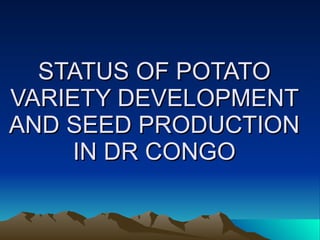Status of potato in dr congo
- 1. STATUS OF POTATO VARIETY DEVELOPMENT AND SEED PRODUCTION IN DR CONGO
- 2. Introduction Production zones: highlands in eastern part of country Province Orientale Nord kivu Sud Kivu Katanga Western part of country Bandundu Bas-Congo
- 3. Climatic conditions 17-19 1100-1500 April October 1700-1800 Orientale 18-19 1000-1600 Nov.-Febr. 1700-2000 Katanga 19-21 1200-1800 Sept.-Oct. March-Apr. 1700-2300 Sud Kivu 14-16 1300-1800 Oct.-Nov. Febr., Apr. 2000-2500 Nord Kivu T ? C Rainfall (mm) Seasons (planting) Altitudes (m) Provinces
- 4. Variety evaluation, selection and release process I INTRODUCTORY PLOTS: In the research station; 1-5 tubers/clone/plot; no replication; 1 season. II SELECTION PLOTS : In the research station; 5-10 tubers/clone/plot; 2-3 replications; local check is incorporated; 1 season. III VARIETY TRIALS : in the station; 10-20 tubers/clone/plot; 3-4 replications; 2 seasons. IV MULTILOCATIONAL : 4-6 locations through growing potato zones; TRIALS 10-15 tubers/clone/plot; 3 replications; 2 seasons V ON-FARM TRIALS : In the farmers¡¯ fields; 10-20 tubers/clone /farmer; 4-6 farmers by localities; each farmer is considered as a replication/location; 2 seasons. VI RELEASE
- 5. Release requirements High yield Resistance/Tolerance to LB, BW, VIRUSES Tuber characteristics: Skin color: pink, red, white Shape : oblong, ovate, round, elliptic dormancy:short(2 months), medium(3 months) Maturity: early(3 months), medium(3 ? months) Culinary qualities:consistency,mealy
- 6. Data collection In the steps I and II of evaluation, i.e. introductory plots and selection plots, especially for tuber families, attention is paid to : plant height(score:1-5), 1=low; 5=high Blooming(score:0-5), 0=absent;5=abundant Vigor(score:1-9), 1=very weak; 9= very vigorous Maturity(1-7), 1=late; 7=very early Tuber characteristics: shape, skin color, eye deph
- 7. Data collection (cont¡¯d) In the steps III, IV and V, the following data are collected: Vigor(1-9) Maturity(1-7) Late blight(0-100):0=0%of leaves attacked; 100=100% of leaves destroyed Yield and its components
- 8. Variety characteristics considered by farmers and consumers for adoption Farmers: High yield Resistance/tolerance to diseases(LB,BW) Earliness Short dormancy Good taste Consumers: Size and shape Skin color Culinary qualities
- 9. Seed production schemes There is no formal potato seed system in DR Congo yet. Nevertheless, INERA is the only national institution involved in pre-basic and basic seed production. There are some development projects,NGO¡¯s and progressive farmers who are involved in potato seed production.
- 10. Seed production (cont¡¯d) As there is no an elaborate seed certification program, INERA uses rigorously simples techniques of positive and negative selection to keep seed stocks in a healthy and highly productive state year after year. Seed growers apply the same techniques in their seed potato production plots.
- 11. Available facilities and staff in the potato program Facilities: 1 computer 1 vehicle 2 diffused light stores 2 motorcycles Staff: 1 M.Sc. (Agronomist/Breeder) 2 Ing.Agr.(A 0 ,Post harvest/Food scientist) 2 B.Sc.(A 1 ) 2 Technicians(Diploma)
- 12. Potato varieties, their characteristics Good Good Good Fair Good Good Good Good Good Good Good Storability Tolerant Tolerant 90-105 Shallow to medium White Marita Susceptible Tolerant 90-105 Medium White 386022.2 Murhula Susceptible Susceptible tolerant > 120 Medium White 800954 Seseni Tolerant Moderate 90-105 Medium Red 381381.20 Kinja Susceptible Tolerant Tolerant 110-130 Shallow Yellow/pur Ple eyes 720118 Cruza 148 Tolerant Tolerant 100 Shallow White 382171.4 Nsimire Resistant Susceptible Tolerant to resistant 120-130 Medium Red 720097 Gahinga Tolerant Tolerant Resistant 120-130 Shallow to Medium Red-White R-8212-6 Mabondo Susceptible Tolerant 90-105 Medium Pink 380606.6 Enfula Susceptible Susceptible Moderate 100-115 Medium Pink 800949 Sangema Susceptible(PLRV) Susceptible Moderate 90-105 Shallow to Medium Red 720049 Montsama Resistance-Virus BW resistance LB resistance Vegetative cycle(days) Eye deph Skin color Clone Nber Variety
- 13. Methods used for variety maintenance Germoplasme multiplication in the field year after year. Protection against pests by spraying. Application of positive selection.
- 14. Sources of seed planted by seed multipliers Research stations. Own stocks NGOs Other producers
- 15. Seed storage Diffused light store at Mulungu Center
- 16. Seed storage (cont¡¯d) Farmer¡¯s diffused light store
- 17. Methods used to break seed dormancy Pit in which seed potatoes are buried to break dormancy
- 18. Bottlenecks in seed production and dissemination Political turmoil Lack of tissue culture lab and screenhouse. Lack of seed potato formal system

















